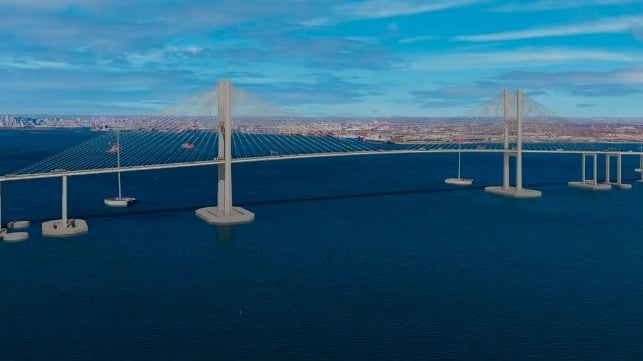Maryland Unveils Design for Replacement of Francis Scott Key Bridge

Nearly one year after the container ship Dali struck and destroyed the Francis Scott Key Bridge in Baltimore, the state of Maryland has unveiled a design for a bridge replacement. The new $1.7 billion span will have a modern cable-stayed design, less vulnerable to a runaway multi-span collapse than the original.
In the early hours of March 26, the container ship Dali got under way from Baltimore's Seagirt Terminal, bound for sea. At about 0125, as she was outbound in the channel making eight knots, Dali suffered a full blackout. Four minutes later, the ship struck the pier on the southwest side of the center span at seven knots, destroying the pier and dropping the entire box-shaped bridge truss into the muddy bottom of the channel. The complex, costly process of extricating all of the steel debris from the waterway and salvaging the ship took until May 2024.
The new bridge design incorporates modern pier protection systems to ward off future ship strikes, as well as a taller bridge deck to allow 45 feet of additional air draft. Kiewit Infrastructure holds a $70 million contract for the design and preparation phase of the bridge's reconstruction, and demolition of remaining debris from the old bridge will begin this spring.
"Commerce and trade are the bedrock of our state, and we will continue to make investments that honor our tradition," said Maryland Gov. Wes Moore in comments at Tradepoint Atlantic, the terminal and warehousing complex next to the bridge site.
The cost of reconstruction will be carried by the federal government, though some amount may be recovered later through the ongoing lawsuit against the vessel's owners and operators. Dali's ownership interests have sued to limit liability to no more than the value of the ship, and a large number of affected parties - city, state, federal, commercial and private, including the families of deceased road workers who fell from the bridge - are seeking to overturn the limit. The first phase of the trial is scheduled for June 2026, and will consider the issue of limited liability. A later second phase will examine the value to the multitude of claims.
The cause of the casualty is multifaceted, and a federal investigation is still under way. The bridge had a well-understood vulnerability to ship strikes on its piers, a product of 1970s design standards combined with the increasing size of modern ships. That design shortcoming was discussed as early as 2006, and state transportation department officials were aware of it at a staff level, but it was never considered critical enough to be worth funding.
NTSB conducted a full technical investigation of the Dali's power system, and the engineering report suggests some possible clues on how the ship lost power in the runup to the allision. A loose cable in a power supply panel showed the potential to cause breakers to open, leading to loss of power. The ship had also suffered intermittent power issues while at the pier, the day before the casualty voyage.
